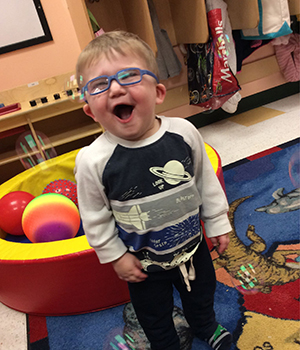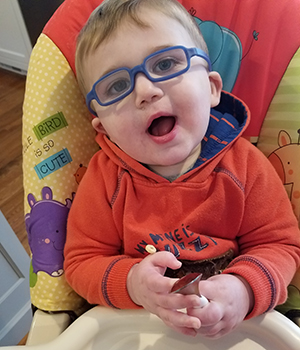Go Ahead, Call Him Four Eyes

Everywhere we go, my little man gets all the attention. Being adorable (yes, I’m biased) helps, but people are always asking about his glasses.
When did he get them?
How did you know he needed them?
Was it a special screening, because our pediatrician didn’t do that?
Will he grow out of them?
Does he really keep them on?
I certainly didn’t know my now 18-month old son needed glasses. He would drop something small on a multi-colored rug and pick it up just fine. He would wave back to me from the other side of the room. Our daycare provider raised no concerns about development. The glasses were a result of a screening at his 12-month well visit.
In Massachusetts, where we live, visions screening are mandated at age three. That is when my daughter was first screened. When I took my son for his 12-month well visit, our pediatrician said she was trying out a new screening tool on younger children. She explained it let them get a head start on addressing any vision issues. Was I up for it? Seemed like a no-brainer.
The screening took less than a minute as the little man looked at a device the size and shape of a cell phone for a photo. Amazingly, they could diagnose on the spot that he was farsighted. A referral to a pediatric ophthalmologist confirmed the diagnosis and—a few tears later (mine not his)—the little man was fitted for glasses.
Vision plays a critical role in a child’s development. Vision problems can affect a child’s ability to learn, play and make relationships. When there is a vision problem, the brain must work harder to compensate. In the extreme, uncorrected problems can lead to permanent vision loss. Even with this knowledge, vision screening procedures, frequency, referral criteria and follow-up vary greatly across the country, according to the National Center for Children’s Vision and Eye Health at Prevent Blindness (NCCVEH).
NICHQ is working with NCCVEH on an initiative to increase the detection and diagnosis of visual impairment in children aged five years and younger. The focus of the work is to enhance the capacity of state public health agencies to use and apply quality improvement to implement universal vision screening for preschool-aged children. Participants recently shared some key lessons-learned so other states can consider what strategies could be beneficial within their own systems and policy for children’s eye care.

We are lucky that my little man’s eyes aren’t too bad. If he didn’t get his first screening until age 3, it’s likely he would have had to patch the weaker eye to build it up in addition to the glasses. Our ophthalmologist said, in her experience, when they get glasses on kids before 2 years old, they are more likely to wear them than kids between 2- 4 years old. While anecdotal and not evidence-based, it seems like even more reason to make sure vision screenings are made available to children at well visits at younger ages.
As we continue at NICHQ to work with partners and stakeholder to have an impact on the children’s vision screening system, I’m thankful that our pediatrician offered the early screening. I’m lucky we have access to a high-quality pediatric ophthalmologist close to our home. I’m appreciative of the network of families of children with glasses that I’ve connected with online who provide support and guidance in the pediatric vision journey. And I’m amazed at how my little man embraces the glasses with gusto and infectious giggles.
Written by Cindy Hutter, MBA, NICHQ’s Director of Marketing and Digital Strategy.
